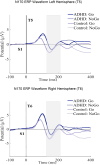Facial Affect Recognition and Executive Function Abnormalities in ADHD Subjects: An ERP Study
- PMID: 39698976
- PMCID: PMC12130601
- DOI: 10.1177/15500594241304492
Facial Affect Recognition and Executive Function Abnormalities in ADHD Subjects: An ERP Study
Abstract
Attention-deficit/hyperactivity disorder (ADHD) affects approximately 12% of children worldwide. With a 50% chance of persistence into adulthood and associations with impairments in various domains, including social and emotional ones, early diagnosis is crucial. The exact neural substrates of ADHD are still unclear. This study aimed to reassess the behavioral and neural metrics of executive functions and neural substrates of facial affect recognition. A total of 117 ADHD patients and 183 healthy controls were evaluated by two Go/NoGo tasks: the classic visual continuous performance test and the emotional continuous performance test, which requires facial affect encoding. Group differences between ADHD subjects and healthy controls were assessed using analysis of covariance (ANCOVA), with age and sex included as covariates. Dependent variables comprised behavioral (number of omission and commission errors, reaction time, and reaction time variability) and neurophysiological measures (event-related potentials [ERPs]). As the main result, we identified significant differences between ADHD patients and healthy controls in all behavioral metrics, one neural marker of action inhibition (P3d) and the facial processing marker (N170). The differences were moderate-to-large when expressed as effect size measures in behavioral variables and small-to-moderate for neurophysiological variables. The small-to-moderate effect sizes obtained from the neurophysiological measures suggest that ERPs are insufficient as sole markers for effectively screening emotion and face processing abnormalities in ADHD.
Keywords: ECPT; ERP; VCPT; attention-deficit hyperactivity disorder; facial affect recognition.
Conflict of interest statement
Declaration of Conflicting InterestsThe authors declared no potential conflicts of interest with respect to the research, authorship, and/or publication of this article.
Figures





Similar articles
-
Facial emotion recognition deficits in children with and without attention deficit hyperactivity disorder: a behavioral and neurophysiological approach.Neuroreport. 2017 Sep 27;28(14):917-921. doi: 10.1097/WNR.0000000000000858. Neuroreport. 2017. PMID: 28763378
-
Cortical deficits of emotional face processing in adults with ADHD: its relation to social cognition and executive function.Soc Neurosci. 2011;6(5-6):464-81. doi: 10.1080/17470919.2011.620769. Epub 2011 Oct 3. Soc Neurosci. 2011. PMID: 21961874
-
Behavioral and Neurophysiological Markers of ADHD in Children, Adolescents, and Adults: A Large-Scale Clinical Study.Clin EEG Neurosci. 2021 Sep;52(5):311-320. doi: 10.1177/1550059421993340. Epub 2021 Mar 25. Clin EEG Neurosci. 2021. PMID: 33764193 Free PMC article.
-
N170 in attention deficit hyperactivity disorder: Systematic review.Int J Psychophysiol. 2025 Jul;213:112585. doi: 10.1016/j.ijpsycho.2025.112585. Epub 2025 May 9. Int J Psychophysiol. 2025. PMID: 40349985
-
Recognition of emotional facial expressions in adolescents with attention deficit/hyperactivity disorder.J Adolesc. 2020 Jul;82:1-10. doi: 10.1016/j.adolescence.2020.04.010. Epub 2020 May 19. J Adolesc. 2020. PMID: 32442797 Review.
References
-
- Swanson J, Deutsch C, Cantwell D, et al. Genes and attention-deficit hyperactivity disorder. Clin Neurosci Res. 2001;1(3):207–216. doi:10.1016/S1566-2772(01)00007-X - DOI
-
- Association DAP. Diagnostic and statistical manual of mental disorders: DSM-5. 2013. Accessed May 21, 2022. https://www.amberton.edu/media/Syllabi/Spring%202022/Graduate/CSL6798_E1...
-
- Organization WH. International statistical classification of diseases and related health problems: Alphabetical index. 2004. Accessed May 21, 2022. https://books.google.com/books?hl=en&lr=&id=Tw5eAtsatiUC&oi=fnd&pg=PA1&d...
MeSH terms
LinkOut - more resources
Full Text Sources
Medical
Research Materials

